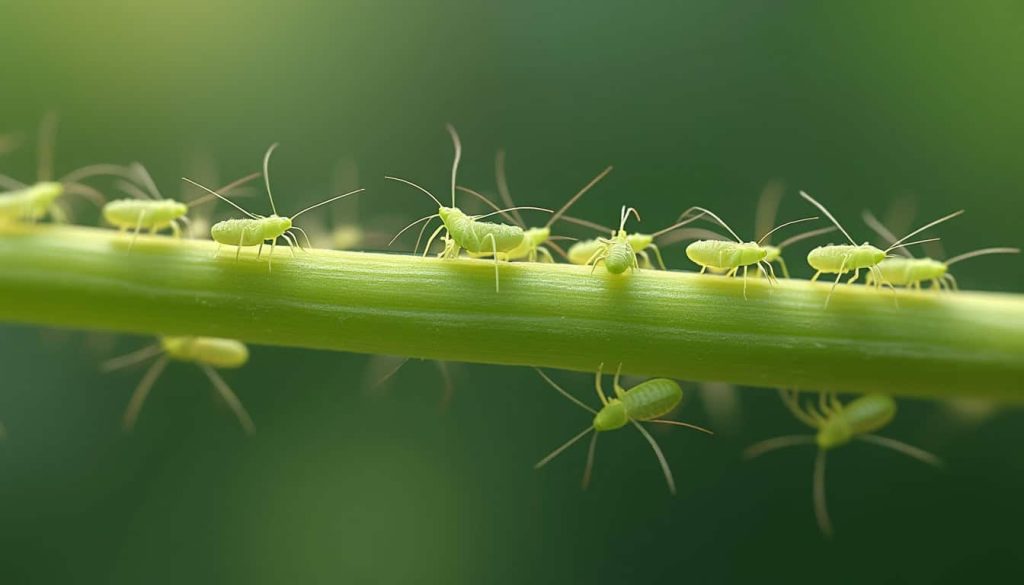Understanding Common Flower Pests and Diseases and How to Combat Them

Understanding Flower Pests
Maintaining a beautiful garden is an aspiration shared by many, yet the journey can be rife with challenges. One of the most significant obstacles comes from pests and diseases, which can transform a vibrant flower bed into a field of despair. Identifying these threats is essential for any gardener who wishes to enjoy the full splendor of their floral displays.
Among the myriad of garden invaders, some pests are more notorious than others. For instance, aphids are small, soft-bodied insects that often gather in clusters on new shoots and undersides of leaves. These pests feed by piercing plant tissues and sucking out sap, leading to stunted growth and curled leaves. If you notice a sticky substance, known as honeydew, on your plants, it may be an aphid infestation. They can also attract sooty mold, which can smother the leaves and hinder photosynthesis.
Another common adversary is the spider mite, nearly invisible to the naked eye. These minuscule creatures thrive in dry conditions and reproduce quickly, generating webs that blanket leaves and stems. Left unchecked, spider mites cause leaf damage that can resemble speckled or stippled patterns. Regularly misting your plants or using insecticidal soap can help combat their presence.
Whiteflies present another challenge, especially in warmer climates. These small, flying insects can quickly diminish the vitality of your flowers by feeding on their sap. They often congregate on the undersides of leaves, where they lay eggs that hatch into nymphs. To identify a whitefly problem, observe for flying adult insects when you disturb the leaves.
Common Flower Diseases
In addition to pests, a range of diseases can afflict flowers, often resulting in discoloration, wilting, or unexpected leaf drop. Powdery mildew stands out as a prevalent fungal disease characterized by a white, powdery coating on leaves. This condition is especially prevalent in warm, dry conditions, and it can inhibit photosynthesis, ultimately affecting the entire plant’s health. Regular pruning and ensuring adequate air circulation are essential in preventing its spread.

Botrytis blight, another fungal foe, typically thrives in overly damp conditions, causing flowers to rot prematurely. Gardeners should be vigilant after periods of excessive rainfall, as this can create the perfect breeding ground for the fungus. Ensuring proper drainage and employing fungicides when needed can mitigate this infection.
Lastly, root rot is often caused by overwatering, leading to the decay of root systems and visible wilting on the above-ground parts of the plant. It’s essential for gardeners to monitor watering practices closely, allowing the soil to dry out between waterings to promote healthy root development.
Preventive Measures and Best Practices
Combatting these challenges not only involves accurate identification but also implementing effective preventive measures. Engaging with your garden regularly allows you to catch issues early. Establishing healthy growing conditions—ensuring proper sunlight, balanced watering schedules, and nutrient-rich soil—can significantly reduce the likelihood of pest invasions and disease outbreaks.
Moreover, employing beneficial insects like ladybugs, which prey on aphids, can bolster your garden’s natural defenses. Additionally, practicing crop rotation and diversifying your plant selections can mitigate the risk of widespread infestations and infections.
By understanding the common threats to your flowers and taking proactive steps, you can safeguard your garden against the menaces of pests and diseases, enabling your blooms to thrive beautifully through the seasons.
EXPLORE MORE: Click here to delve into the world of aromatic herbs</p
Identifying Common Flower Pests
Understanding the complex nature of flower pests is crucial for any avid gardener. While pests can seem overwhelmingly invasive, a knowledgeable gardener can effectively distinguish between beneficial insects and those that threaten the health of their blooms. Consider the following common pests that often infiltrate gardens across the United States:
- Aphids: Often seen as small, green or black teardrop-shaped insects, aphids reproduce rapidly and can be found clustered on tender new growth. Their feeding habits can result in distorted leaves and diminished flowering, making timely intervention essential.
- Spider Mites: These arachnids are noteworthy for their evasiveness, often hiding beneath leaves. Their detrimental feeding causes leaves to take on a mottled appearance, a clear signal that they are munching away on your plants. They thrive in dry conditions, making regular monitoring necessary, particularly during warm seasons.
- Whiteflies: Much like a miniature moth, these pests can be seen fluttering around your plants, especially when disturbed. Their presence often means trouble, as they weaken flowers by sucking out vital sap, leading to yellowing leaves and stunted growth.
- Thrips: Though small and often overlooked, thrips can cause considerable harm to flowers. They feed on plant cells, leading to silvery streaks or spots on foliage and petals, ultimately ruining their aesthetic appeal.
Regular inspections of your plants can help you identify these pests early on. Utilizing sticky traps or neem oil can assist in controlling pest populations before they spiral out of control. Early intervention is always preferable to grappling with a full-blown infestation.
Understanding Common Flower Diseases
Beyond pests, various diseases can also wreak havoc on your prized floral treasures. An understanding of common conditions and their implications will empower you in preserving the beauty of your garden. Here are a few diseases to watch for in your flowering plants:
- Powdery Mildew: This fungal disease thrives in high humidity and shady areas, showcasing a stark white powder on the leaves and buds. It’s a telltale sign that your plants are under stress and need increased sunlight and airflow.
- Botrytis Blight: A notorious enemy in damp conditions, botrytis manifests as gray, fuzzy mold on flowers and foliage. This disease thrives in wet, crowded areas, making good air circulation and proper watering techniques critical for prevention.
- Root Rot: Resulting from overwatering or poorly draining soil, root rot can decimate a plant before the gardener even realizes something is wrong. If you notice wilting leaves and a foul smell from the soil, this could be a sign of root rot.
Implementing routine garden upkeep can help diminish the impact of these diseases. Allowing sufficient space between plants ensures airflow and reduces humidity levels, cutting down on fungal growth. Moreover, monitoring soil moisture will prevent overwatering and potential root deterioration.
By paying attention to both the pests and diseases that may threaten your flowers, you are taking significant strides towards achieving a flourishing garden. Practical knowledge teamed with proactive care can make a world of difference in maintaining your cherished floral haven.
| Common Flower Pests | Management Techniques |
|---|---|
| Aphids | Use insecticidal soap or introduce natural predators like ladybugs. |
| Spider Mites | Maintain humidity and apply neem oil to control infestations. |
| Powdery Mildew | Improve air circulation and use fungicides based on sulfur or potassium bicarbonate. |
| Black Spot | Prune infected leaves and apply systemic fungicides for prevention. |
Understanding flower pests and diseases is crucial for cultivating healthy plants. A strong strategy begins with early detection of pests such as aphids, known to sap plant vitality, or spider mites, which often thrive in dry conditions. Regular monitoring and employing natural control measures can dramatically reduce the impact of these pests on your garden.Moreover, tackling diseases such as powdery mildew and black spot involves not only effective treatments but also proactive measures like improving air circulation and selecting resistant plant varieties. The art of managing these challenges lies in your ability to recognize symptoms early and respond quickly. Investing time in understanding your plants’ needs and stress factors can yield a thriving flower garden. By using the right tools and techniques, you can combat these threats effectively and enjoy vibrant blooms all season long.
DISCOVER MORE: Click here to learn how to create a vertical garden!
Strategies for Combatting Flower Pests
Once pests have made their unwelcome entrance into your garden, taking swift action is essential. Here are several effective strategies to help mitigate the impact of flower pests:
- Natural Predators: Encouraging beneficial insects, such as ladybugs and lacewings, can help regulate pest populations. These predators feed on aphids and other harm-inducing bugs, creating a natural balance in your garden ecosystem.
- Insecticidal Soaps: These targeted treatments are safe for plants but deadly to many soft-bodied insects. Spraying a diluted solution of insecticidal soap on affected areas can encourage pest control without harming beneficial insects.
- Companion Planting: Some plants serve as natural repellents to pests. For instance, planting marigolds alongside your flowers can deter nematodes and aphids, protecting your blooms without the use of harsh chemicals.
- Neem Oil: Extracted from the seeds of the neem tree, this organic pesticide disrupts the life cycle of pests like aphids and whiteflies. A diluted neem oil spray can provide a versatile defense against numerous offenders.
Utilizing a combination of these tactics not only protects blooming flowers but also promotes a healthier garden environment overall, acting as a safeguard against future infestations.
Proactive Measures Against Flower Diseases
Preventing flower diseases involves attentive gardening practices that foster healthy growth. To effectively combat common flower diseases, keep the following strategies in mind:
- Proper Airflow: Spacing your plants properly creates vital airflow and reduces humidity, which can greatly prevent fungal diseases like powdery mildew from taking hold. A general rule of thumb is to space plants according to their mature width to enhance ventilation.
- Regular Watering Practices: Instead of giving your plants a generous soaking in one go, aim for consistent, moderate watering practices. Watering early in the day allows plants to dry thoroughly by evening, preventing conditions conducive to root rot and fungal growth.
- Sanitation: Keeping your garden clean can drastically reduce the chances of disease. Regularly remove dead or decaying plant material, as it can serve as a breeding ground for pathogens waiting to invade healthy plants.
- Resistant Varieties: When choosing plants for your garden, consider varieties that are bred for disease resistance. This can save you time and frustration in combating diseases that are prevalent in your area.
By implementing these proactive measures, you create an environment where your flowering plants can not only survive but thrive, significantly reducing the likelihood of pest and disease issues.
Understanding and combating common flower pests and diseases is an ongoing learning process for any gardener. Adapting your methods and strategies as you gain experience can lead to a vibrant, healthy garden filled with flourishing blooms!
DISCOVER MORE: Click here for sustainable herb cultivation tips
Conclusion
In conclusion, understanding common flower pests and diseases is crucial for any gardener striving to maintain a vibrant and flourishing garden. By familiarizing yourself with the various threats to your flowering plants—from aphids and spider mites to powdery mildew and root rot—you empower yourself to take informed action. The strategies for combatting pests, including employing natural predators and utilizing organic solutions like neem oil and insecticidal soaps, can significantly enhance the health of your garden ecosystem.
Moreover, adopting proactive measures against diseases, such as ensuring proper plant spacing for airflow and implementing good sanitation practices, creates a fortification against potential invasions. Choosing resistant varieties can also streamline your gardening efforts, saving you both time and the heartache of losing beloved blooms.
As you venture through your gardening journey, remember that a mix of vigilance, adaptability, and proactive care can lead to remarkable results. Embracing these techniques not only ensures immediate protection for your flowers but also fosters long-term health and resilience in your garden. Armed with knowledge and effective strategies, you can cultivate a flourishing paradise of color and life, destined to thrive against the challenges posed by pests and diseases. Continuously exploring new information and practices will keep your gardening skills sharp, ultimately contributing to the success of your floral endeavors.


